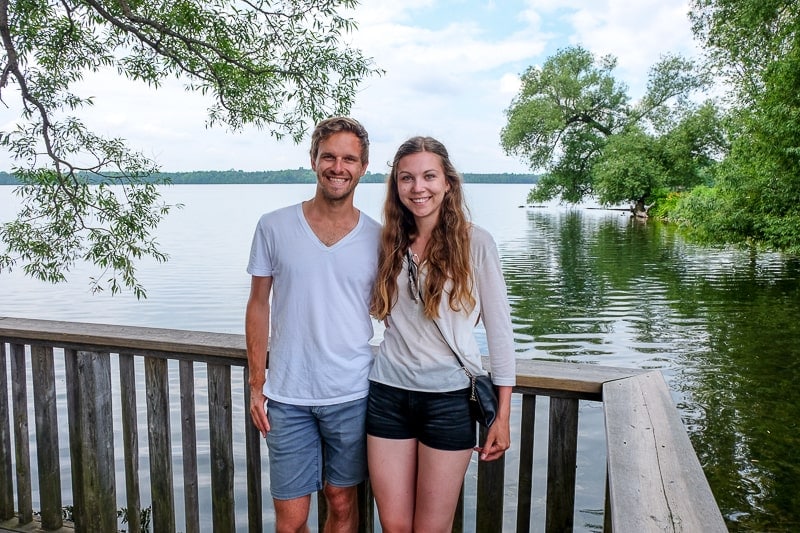Here’s A Classic Paella Valenciana Recipe Shared By A Spaniard!
If you’re looking for a traditional and authentic Spanish dish, look no further than Paella Valenciana, considered the original Spanish paella recipe.
Originating from the Valencia region, it’s no surprise that paella is a popular dish to try when visiting Valencia.
Paella Valenciana is a hearty and flavorful dish that is made with chicken, rabbit, garrofó beans, flat green beans, short-grain rice, and other ingredients such as saffron.
Authentic Paella Valenciana doesn’t contain any seafood and is often a bit different from the idea visitors to Spain tend to have about paella.
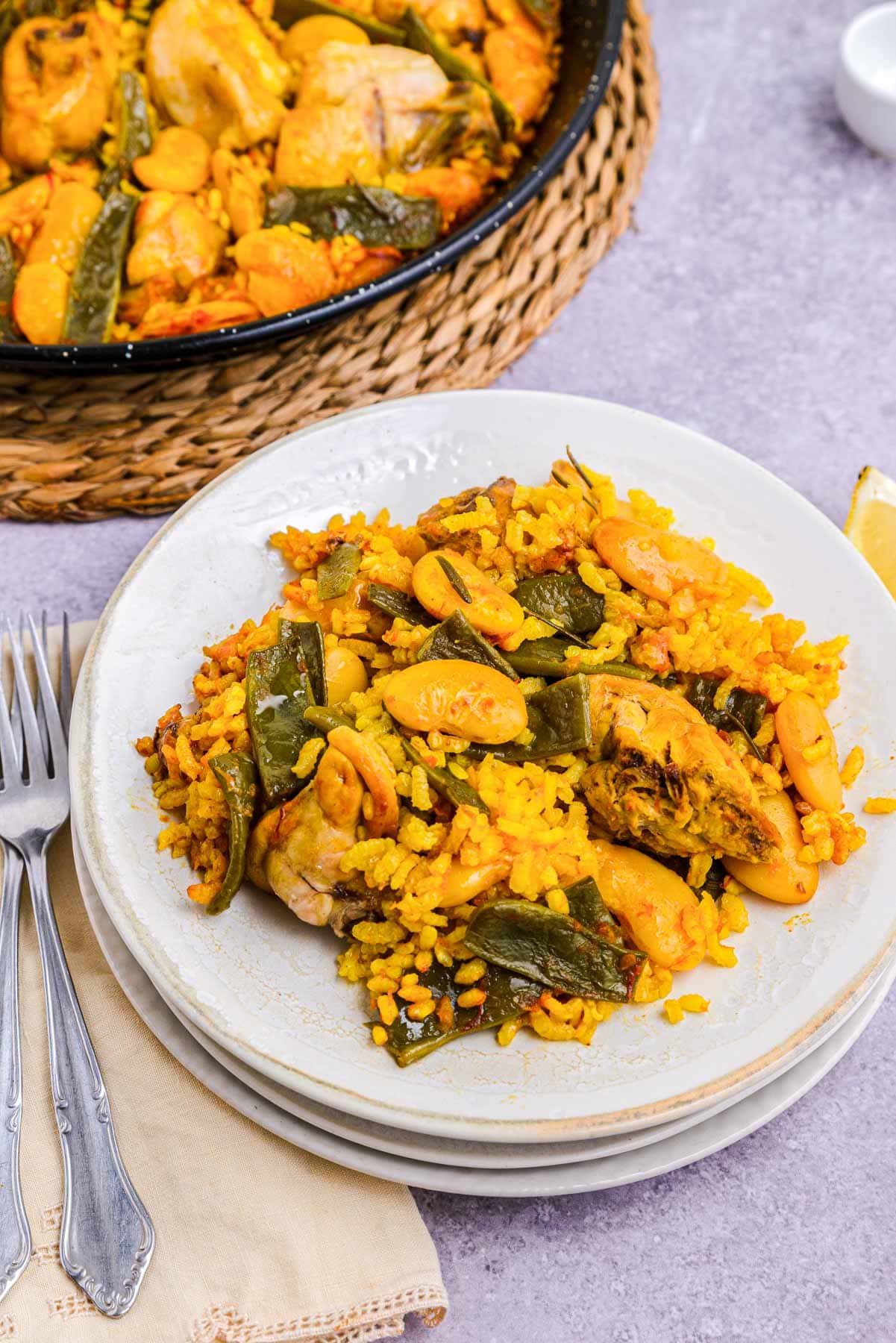
In general, the world of paellas and arroces is quite broad, and there are many different recipes – there isn’t just one kind of paella.
A proper paella always includes a thin layer of rice with ingredients that have been cooked om the paella pan (and not placed on top of the rice afterward).
Some paella recipes – like the famous Paella de verduras (vegetable paella) – include different types of vegetables. Other recipes include different types of seafood.
Normally, paella does not mix meat and seafood. This only really happens in the case of the infamous “paella mixta”, which includes chicken, prawns, and mussels and was created for tourists.
Ingredients
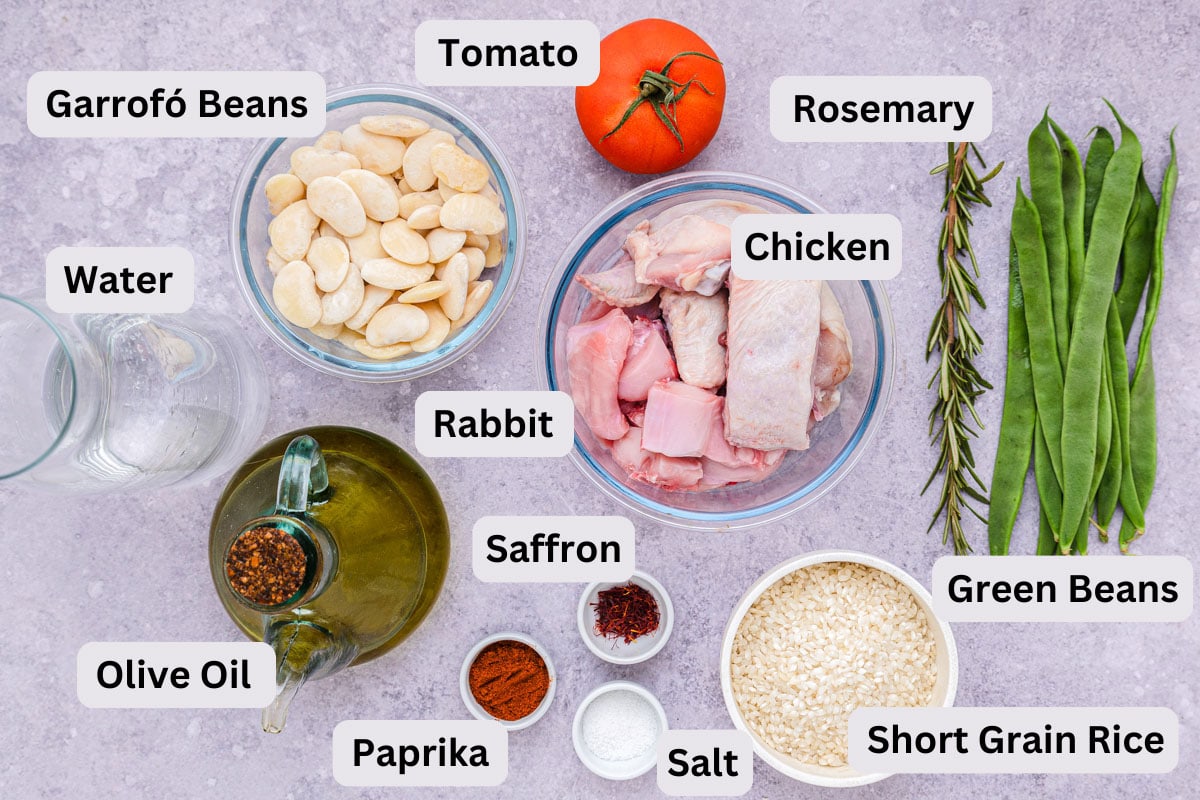
Here are the paella ingredients that you will need to make this recipe:
- Short-grain rice – Short-grain rice like Bomba, Sendra, or Calasparra varieties are recommended. Avoid long-grain or parboiled rice. See recipe tips section for more info.
- Chicken pieces – Preferably bone-in cuts such as chicken thighs, wings, and drummettes. Avoid chicken breast which tends to dry out easily.
- Rabbit pieces – Traditional ingredient in Paella Valenciana, but if you can’t find rabbit, or don’t like it, you can make your paella with chicken only.
- Garrofó beans – A type of white broad beans cultivated in Valencia. Fresh or frozen, not dried. You can also use regular butter beans (see recipe tips section below).
- Green beans – Preferably flat green beans, but rounder green beans also work.
- Tomato – To make the sofrito.
- Saffron threads – Add color and flavor. If possible, use it in threads – it’s a bit pricey but gives the best results. If you can’t find it in threads, powder will work too. Avoid using turmeric as it would drastically change the flavor.
- Rosemary sprig – Adds extra flavor. If you can’t find fresh rosemary, you can use 1 teaspoon dried rosemary.
- Paprika – Preferably mild paprika, but you could also use smoked paprika.
- Olive oil – Doesn’t have to be extra virgin olive oil (can be light olive oil), but avoid using any other vegetable oil since it would drastically change the flavor.
- Salt – To enhance the overall flavor.
- Water – Some hot water to infuse the saffron; some more to make the stock and cook the rice.
Recipe Tips and Substitutions
Before you make this Paella Valenciana recipe, have a good read through these recipe tips so your paella turns out delicious:
- The type of rice you choose can make or break your paella. For best results, use short-grain rice like Bomba, Sendra, or Calasparra. If you can’t find any of these, just choose one that is white, short, and round. Italian risotto rice can also work, especially the Carnaroli variety, but don’t use sushi rise as it will result in sticky paella. Avoid using basmati or any long-grain rice, whole-grain rice, and parboiled rice.
- While traditional Paella Valenciana includes rabbit, you can achieve delicious results using only chicken if rabbit is not readily available.
- Garrofó is a specific white broad bean grown in Valencia that can be quite difficult to find outside of Spain. You can substitute butter beans, preferably fresh. If you can’t find them fresh, I recommend soaking them the night before and precooking them so that they are cooked or almost cooked when added to the paella pan. Otherwise, you run the risk of them still being uncooked when the rest of the paella is ready.
- Brown the meat and vegetables before adding the water to develop flavor. Each browned bit contributes to the overall taste. This is vital as Paella Valenciana is traditionally made with water instead of (chicken) stock – although some cooks nowadays like to add some chicken stock.
- By making a saffron tea instead of adding the threads directly, we ensure the flavor and color get evenly distributed.
- To make a good paella, especially since it is a fairly large pan, use a large stove/burner. In Spain, we have a round gas stove that you attach directly to the gas bottle to cook paellas. Otherwise, you run the risk that some areas will not be cooked evenly.
- It is crucial not to move the rice once it has been distributed in the pan. Moving the rice will release the starch from it, resulting in a mushier consistency (think Italian risottos!).
- Once you have added the rice, you need to be able to control the heat well. At first, you need medium-high heat, then lower it to medium-low, and then simply let the pan rest with the heat switched off.
How to Make Paella Valenciana – Step by Step Instructions
In this section, we’ll show you exactly how to make Paella Valenciana. All of the recipe process photos have been included so that you can follow along as you make it at home.
Of course, you can also find the detailed recipe card with all the measurements and cooking times at the bottom of this post.
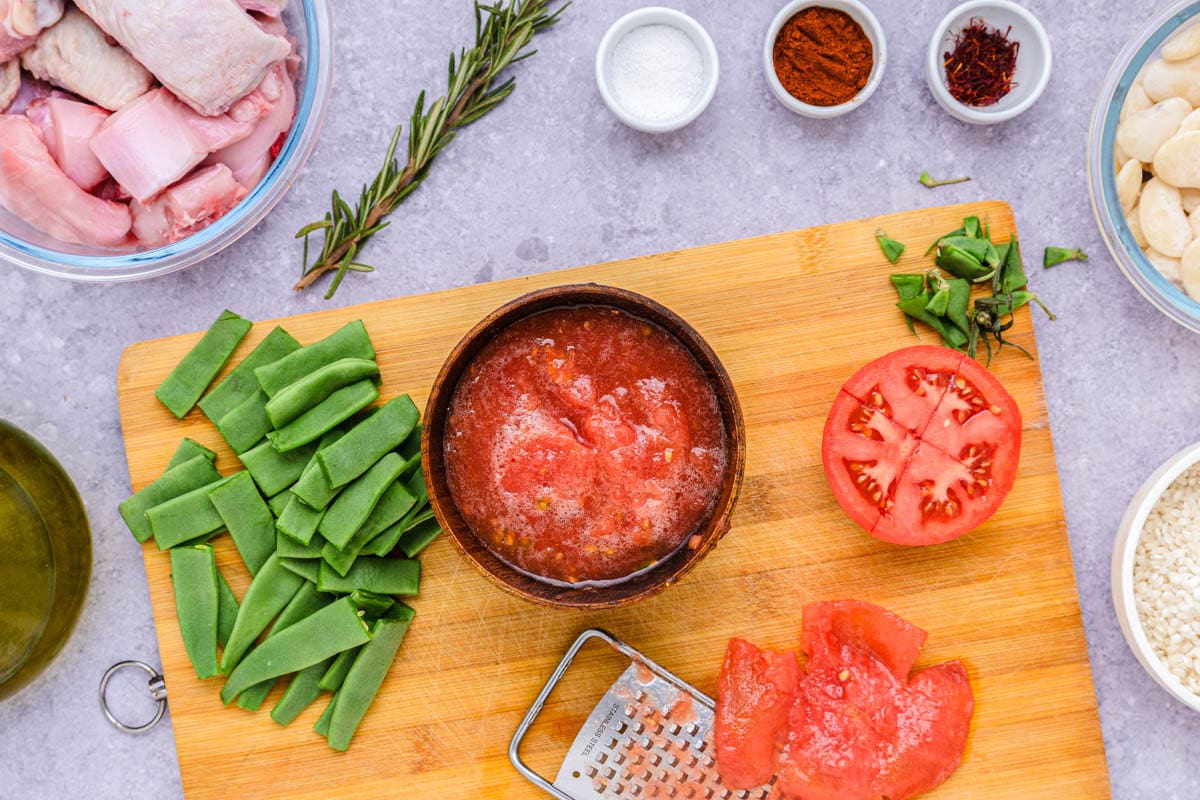
First, prepare the vegetables: Trim the ends of the green beans and cut them into larger pieces. Cut the tomato in half and grate the pulp into a bowl.
In a small bowl, combine the saffron threads with the hot water to make the saffron infusion. Let it sit while you cook the next steps.
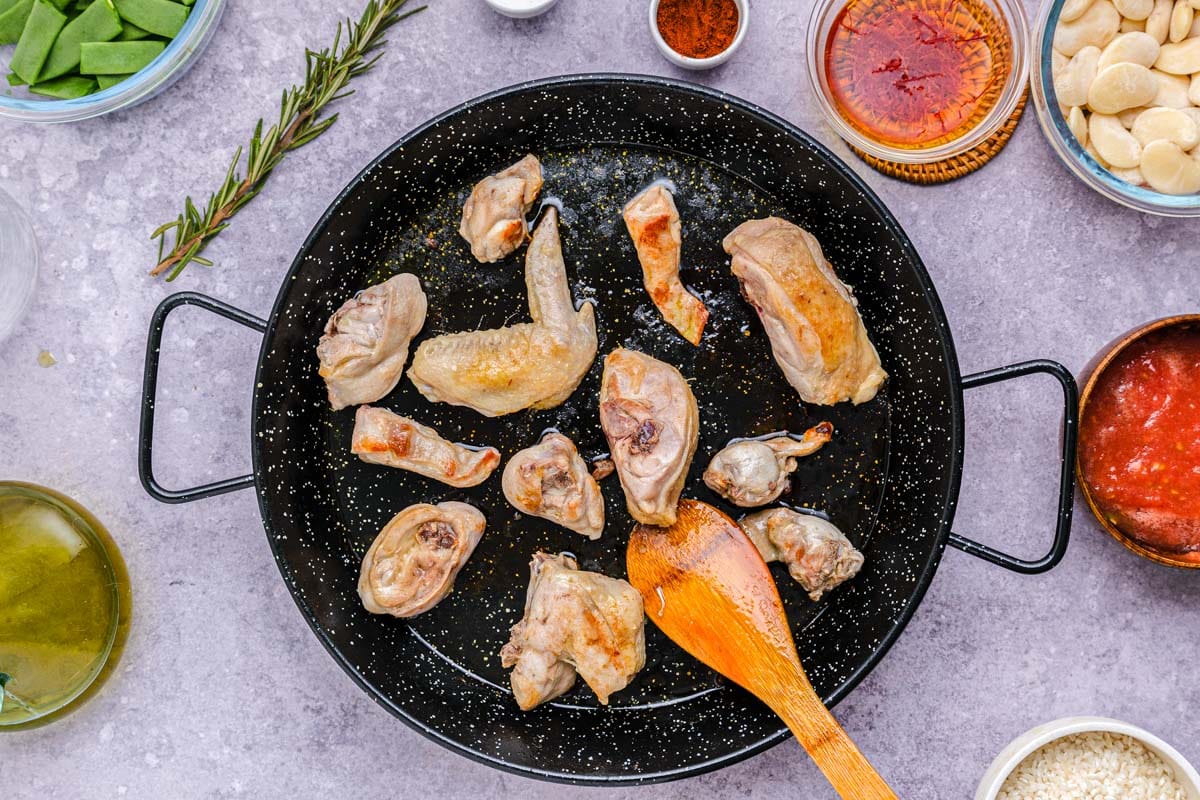
In a paella pan, heat the olive oil and add meat pieces. Season with a bit of salt and cook over medium heat until browned.
Remove the meat from the pan and set aside, or move to the outside of the pan if it is large enough.
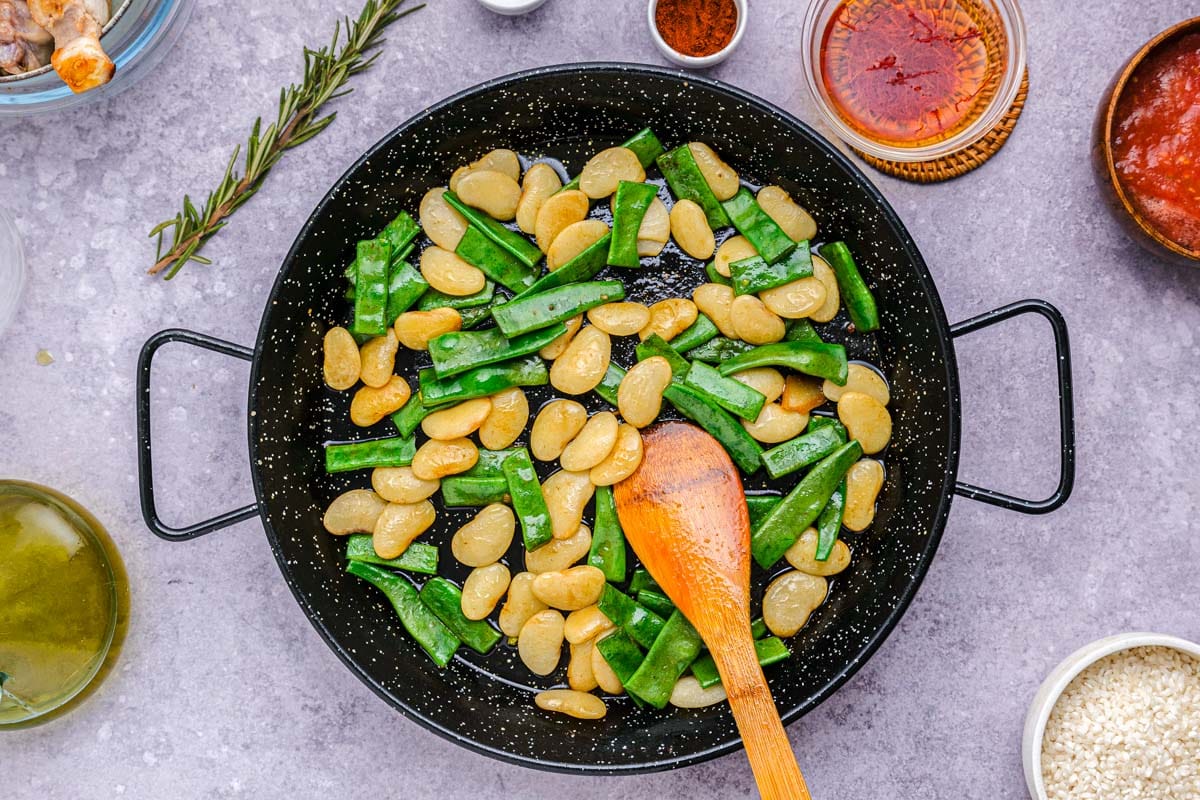
Add the garrofó beans and the green beans to the same paella pan.
Season with a bit of salt, and sauté gently over medium heat for 2-3 minutes, until they change color and are lightly browned.
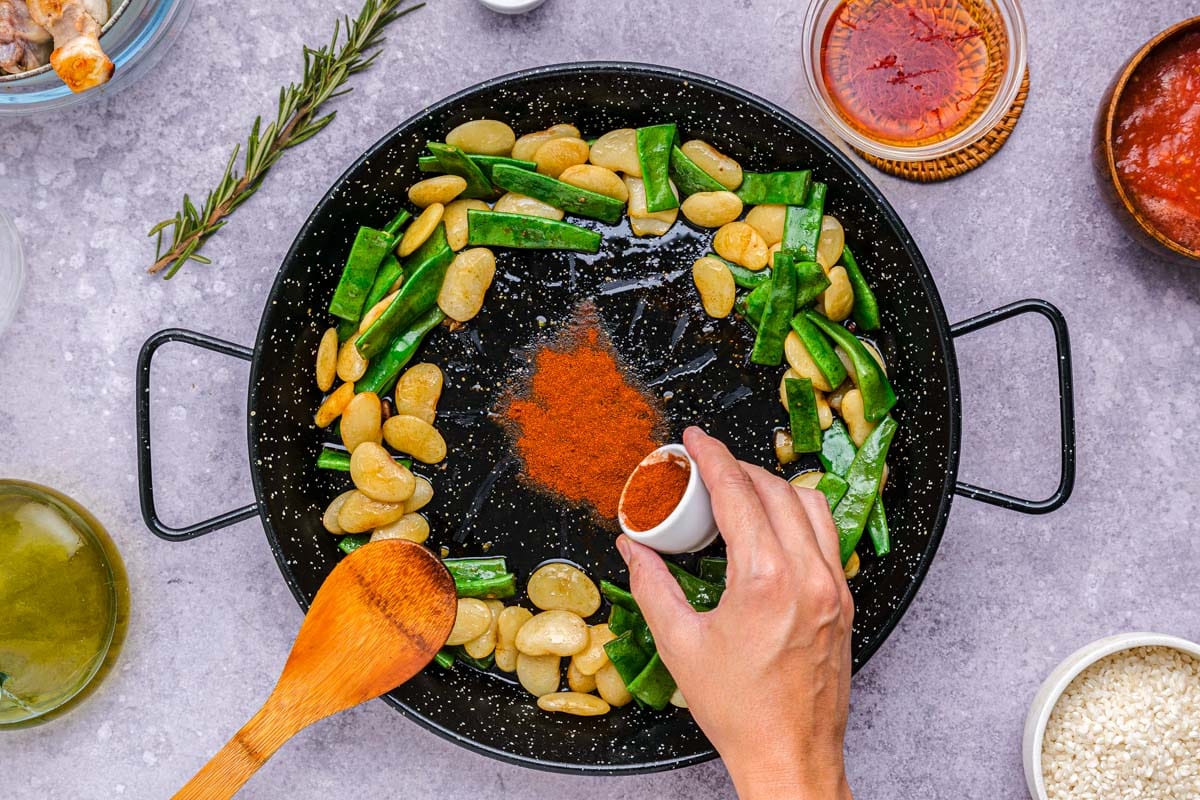
Move the veggies to the sides of the paella pan, leaving the center free.
Add the paprika powder to the center of the paella pan and cook for 30 seconds over low heat, stirring constantly with a wooden spoon or spatula.
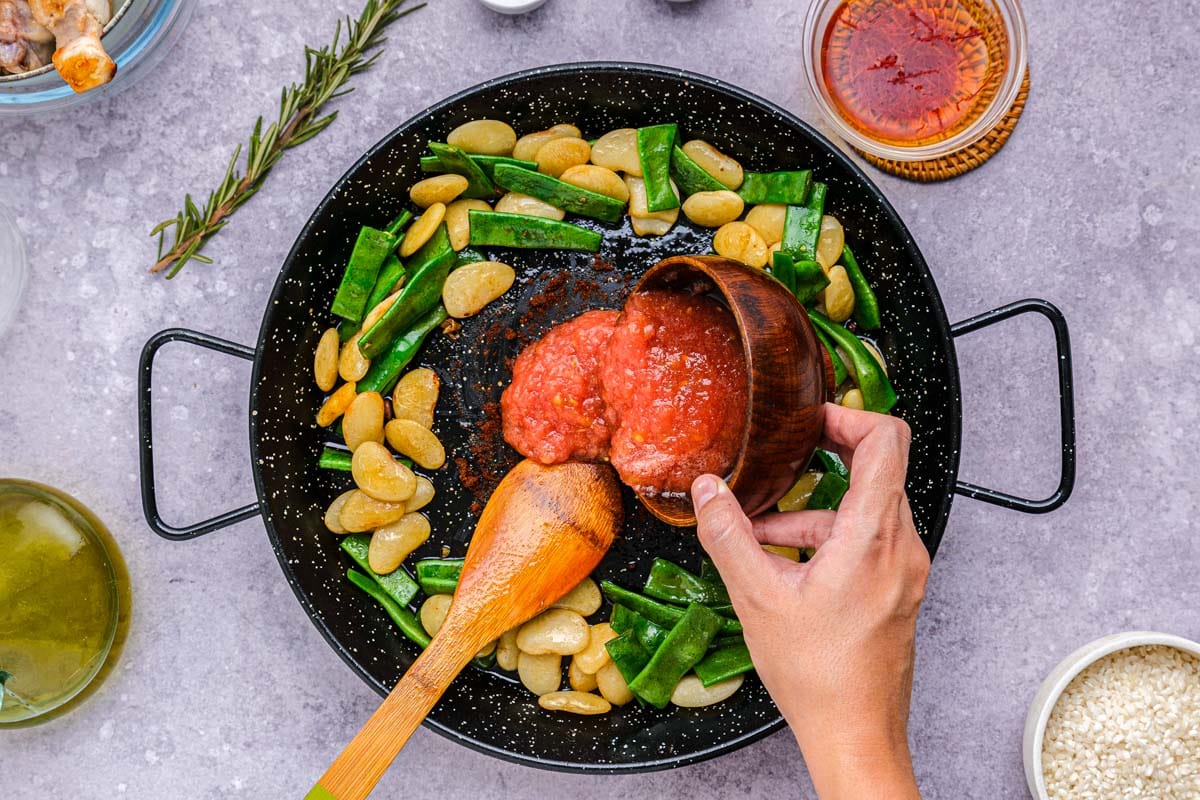
Add the grated tomato, and mix well with the toasted paprika. Cook for a couple of minutes over medium heat. Then mix with the rest of the veggies in the pan.
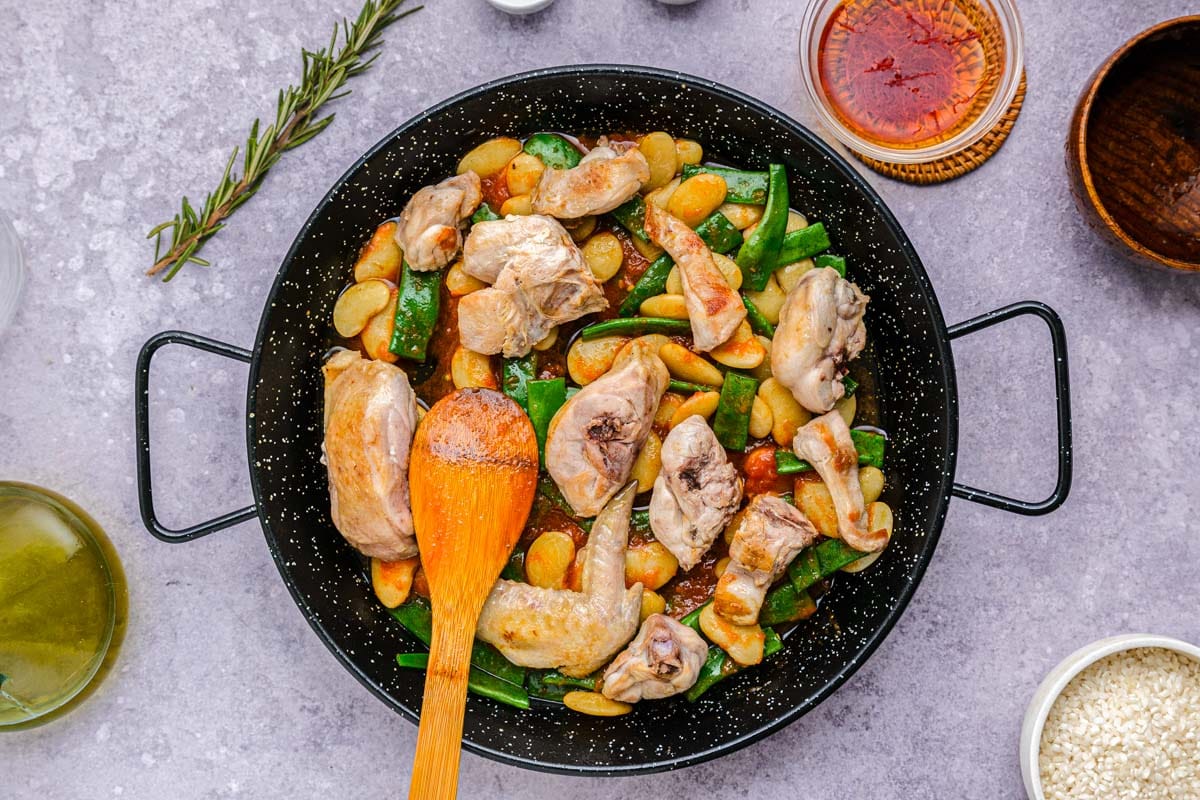
Return the meat to the paella pan along with any juices it may have released.
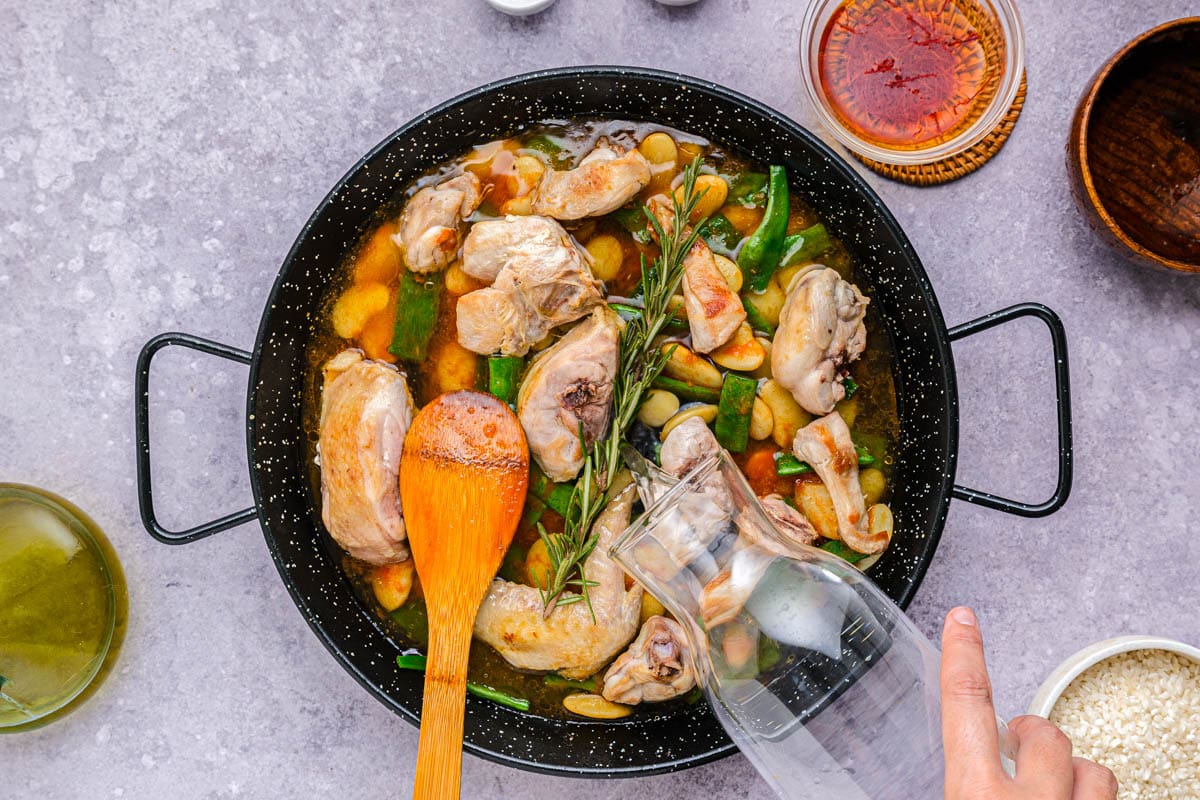
Now add the rosemary sprig, the water, and the rest of the salt to the paella pan.
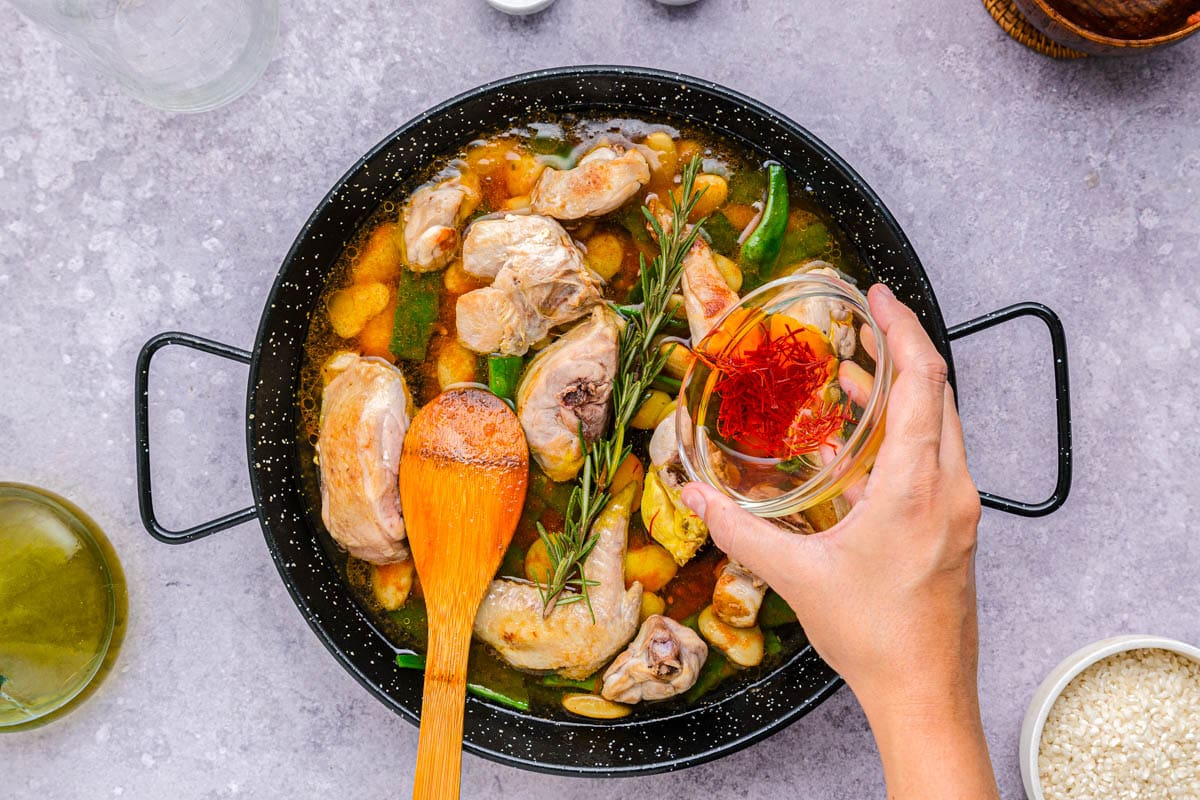
Also add the saffron infusion.
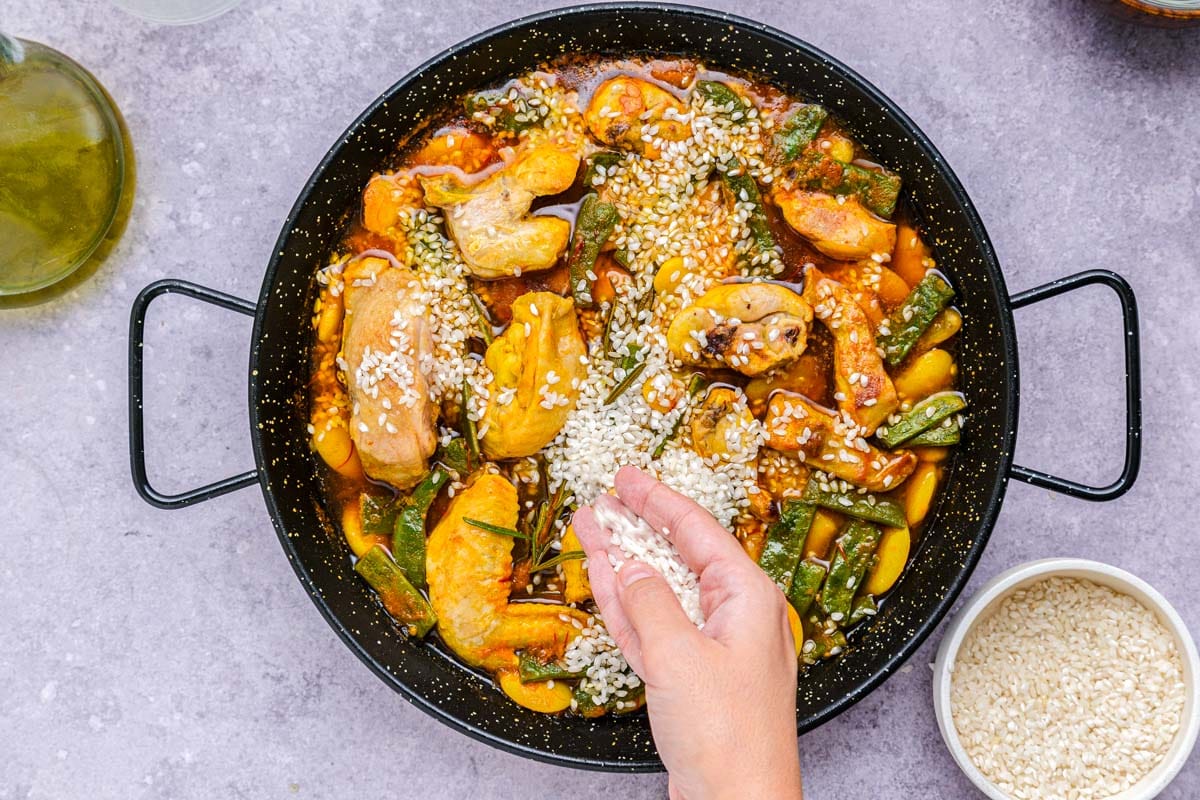
Let it boil over low heat for 20 minutes. Taste and adjust the salt if needed.
Once the stock has been boiling for 20 minutes and the flavors have been extracted, add the rice to the paella pan.
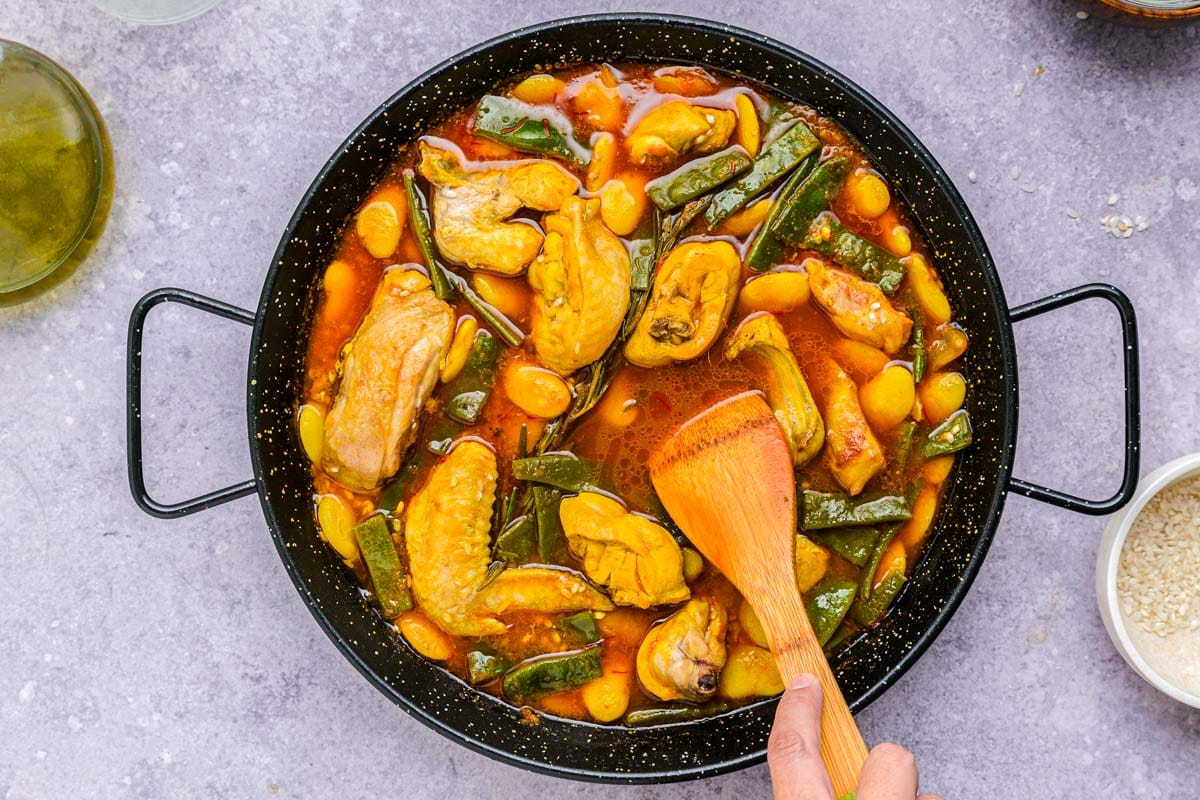
Distribute the rice evenly with the help of the wooden spatula and once settled do not mix again.
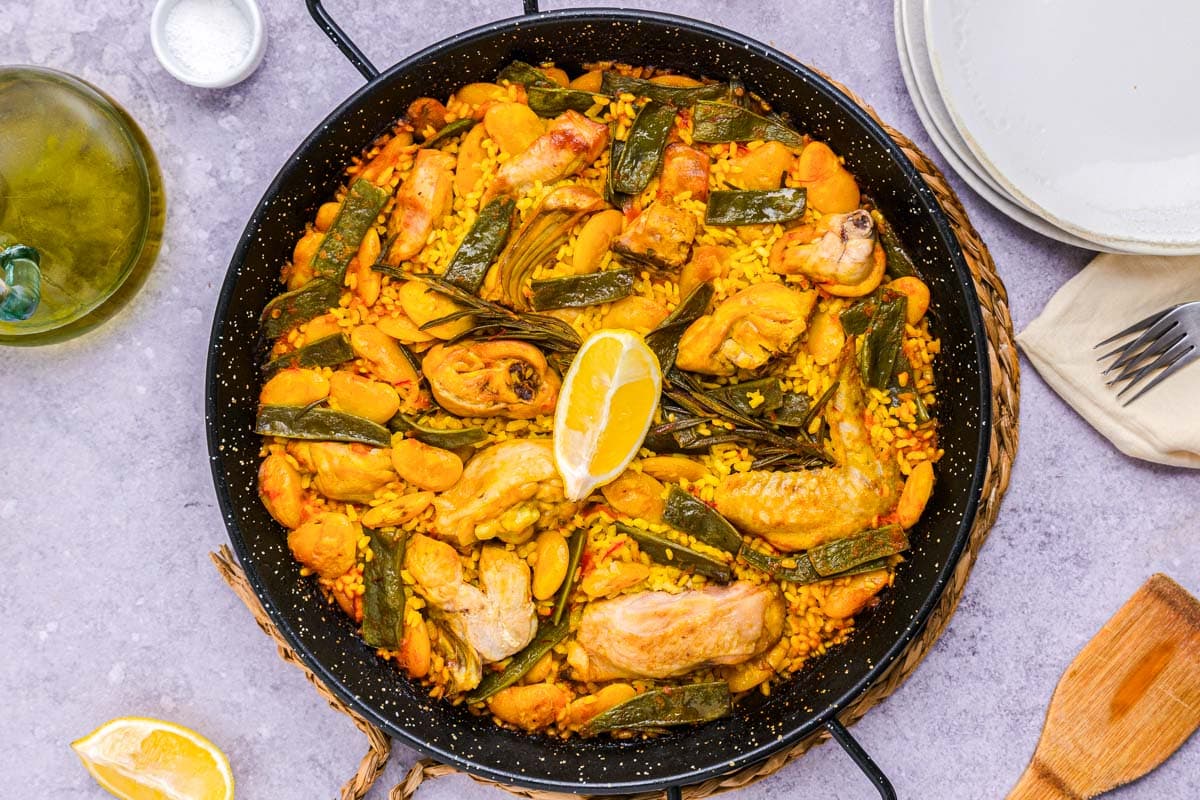
Cook for 15 minutes over medium-high heat until all the water has been absorbed.
If the rice is still undercooked after 15 minutes, cover the paella pan with a lid and let it rest for 5 minutes to finish cooking the rice (with the stove turned off).
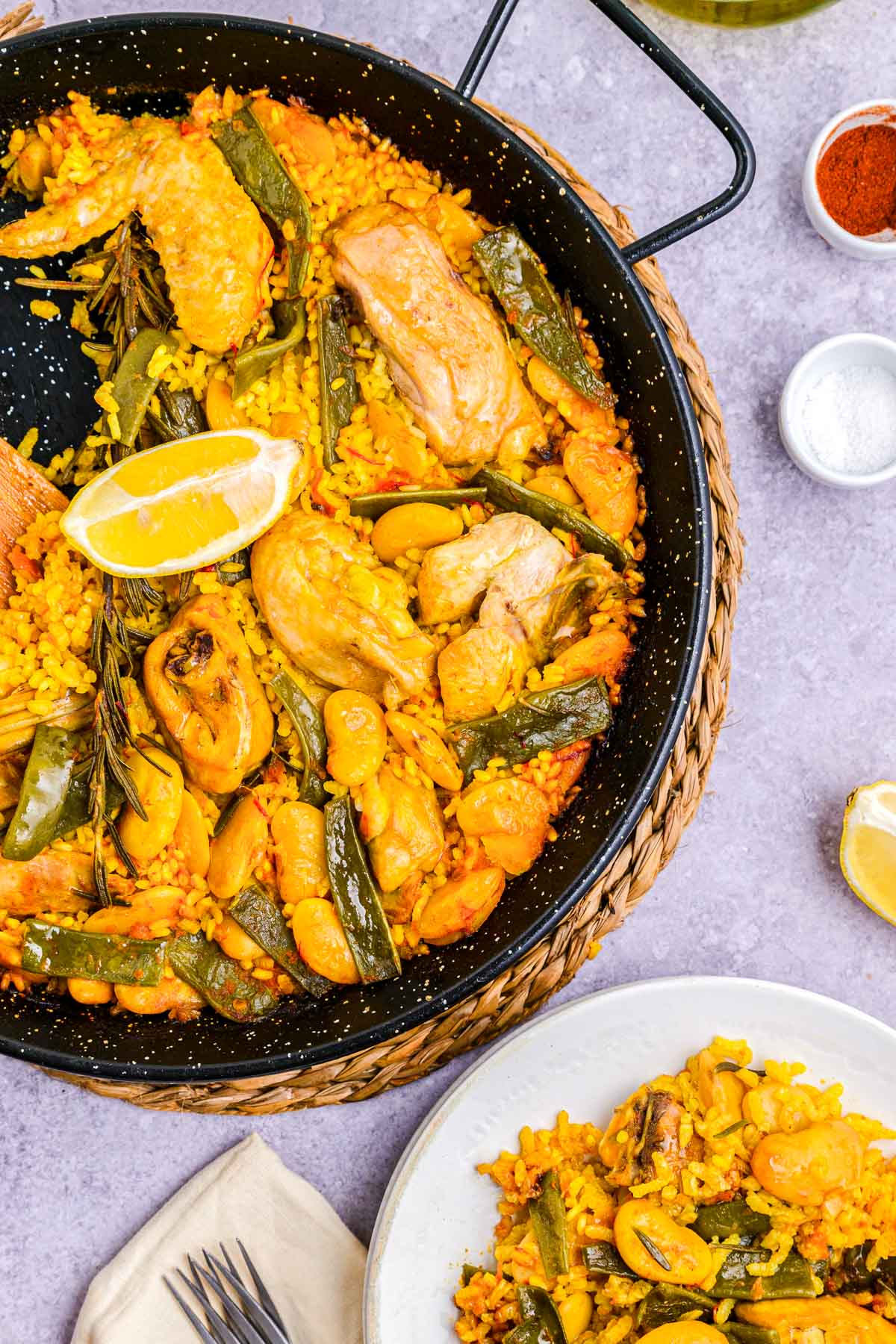
Serve the paella hot with lemon wedges and enjoy!
Storage Tips
For the best taste, paella Valenciana should be eaten right after being made. However, if you have any leftovers, you can store them in a sealed container in the fridge for up to 2 days.
To eat them, gently reheat in a pan with a drizzle of olive oil over medium-low heat.
FAQ
Paella Valencia is traditionally made with chicken, rabbit, garrofó beans (a type of butter bean), flat green beans, and short-grain rice. There are a few other ingredients – such as saffron and rosemary – that are added for flavor and color.
Paella is the general term for the Spanish rice dish prepared in a large, flat pan. It can be prepared in many ways using different ingredient combinations. Paella Valenciana is a specific type of paella that comes from Valencia. It is made with main ingredients like chicken, rabbit, garrofó beans, flat green beans, and short-grain rice.
There are four main types of Paella: Paella Valenciana (rabbit, chicken, rice, and vegetables, no seafood), Paella de verduras (vegetable-only paella), Paella de marisco (seafood-only paella), and Paella mixta (a combo of land meats and seafood).
Paella can be served on plates to individual diners, but another way to eat paella is with a spoon directly from the pan, eating from the outside to the center of the pan.
Related Recipes
If you liked this paella recipe, here are some more savory Spanish dishes you may enjoy as well:
- Vegetable Paella (Paella de Verduras)
- Arroz Negro
- Empanada Gallega (Savory Galician Pie)
- Pan con Tomate (Spanish Tomato Bread)
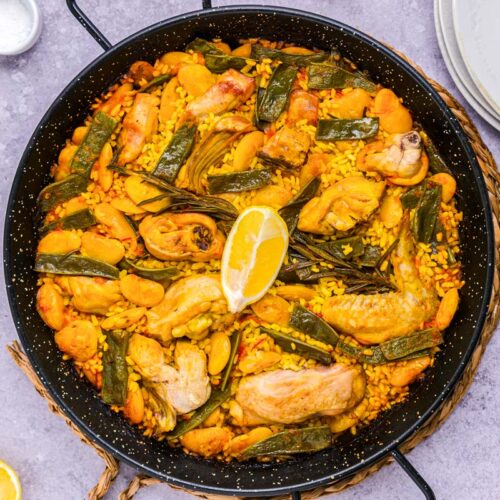
Paella Valenciana
Ingredients
- 3/4 cup short grain rice, around 2.8 oz per person
- 5 ounces chicken pieces
- 5 ounces rabbit pieces
- 3 ounces garrofó beans, a type of butter bean / lima bean
- 3 ounces green beans, flat
- 1 tomato
- 1 tablespoon saffron threads
- 1/3 cup water, hot
- 1 rosemary sprig, fresh; alternatively 1 teaspoon dried rosemary
- 1 1/2 teaspoons paprika
- 1 tablespoon olive oil
- 1 1/2 teaspoons salt, divided
- 5 ounces water
Instructions
- Prepare the vegetables: Trim the ends of the green beans and cut them into larger pieces. Cut the tomato in half and grate the pulp into a bowl.3 ounces green beans, 1 tomato
- In a small bowl, combine the saffron threads with the hot water to make the saffron infusion. Let it sit while you cook the next steps.1 tablespoon saffron threads, 1/3 cup water
- In a paella pan, heat the olive oil and add the pieces of meat. Season with a little salt and cook over medium heat until browned. Remove them from the pan and set aside (if the pan is large enough you can also just move them to the outside of the pan).5 ounces chicken pieces, 5 ounces rabbit pieces, 1 tablespoon olive oil
- Add the garrofó beans and the green beans to the same paella pan. Season with a bit of salt, and sauté gently over medium heat for 2-3 minutes, until they change color and are lightly browned.3 ounces garrofó beans
- Move the veggies to the sides of the paella pan, leaving the center free. Add the paprika powder to the center of the paella pan and cook for 30 seconds over low heat, stirring constantly with a wooden spoon or spatula.1 1/2 teaspoons paprika
- Add the grated tomato, and mix well with the toasted paprika. Cook for a couple of minutes over medium heat. Then mix with the rest of the veggies in the pan.
- Return the meat to the paella pan along with any juices it may have released.
- Add the rosemary sprig, the water, the saffron infusion, and the rest of the salt to the paella pan.1 rosemary sprig, 5 ounces water
- Let it boil over low heat for 20 minutes. Taste and adjust the salt if needed.
- Once the stock has been boiling for 20 minutes and the flavors have been extracted, add the rice to the paella pan.3/4 cup short grain rice
- Distribute the rice evenly with the help of the wooden spatula and once settled do not mix again.
- Cook for 15 minutes over medium-high heat until all the water has been absorbed.
- If the rice is still undercooked, cover the paella pan with a lid and let it rest for 5 minutes to finish cooking the rice (with the stove turned off).
- Serve the paella hot with lemon wedges.
Notes
- The type of rice you choose can make or break your paella. For best results, use short-grain rice like Bomba, Sendra, or Calasparra. If you can’t find any of these, just choose one that is white, short, and round. Italian risotto rice can also work, especially the Carnaroli variety, but don’t use sushi rise as it will result in sticky paella. Avoid using basmati or any long-grain rice, whole-grain rice, and parboiled rice.
- While traditional Paella Valenciana includes rabbit, you can achieve delicious results using only chicken if rabbit is not readily available.
- If you can’t find garrofó beans, you can substitute butter beans (preferably fresh). If you can’t find them fresh, soak them the night before and precooking them so that they are (almost) cooked when added to the paella pan. Otherwise, you run the risk of them still being uncooked when the rest of the paella is ready.
- Brown the meat and vegetables before adding the water to develop flavor. Each browned bit contributes to the overall taste. This is vital as Paella Valenciana is traditionally made with water instead of stock.
- By making a saffron tea instead of adding the threads directly, we ensure the flavor and color get evenly distributed.
- To make a good paella, especially since it is a fairly large pan, use a large stove/burner. Otherwise, you run the risk that some areas will not be cooked evenly.
- It is crucial not to move the rice once it has been distributed in the pan. Moving the rice will release the starch from it, resulting in a mushier consistency.
Nutrition
This nutritional information has been estimated by an online nutrition calculator. It should only be seen as a rough calculation and not a replacement for professional dietary advice.
